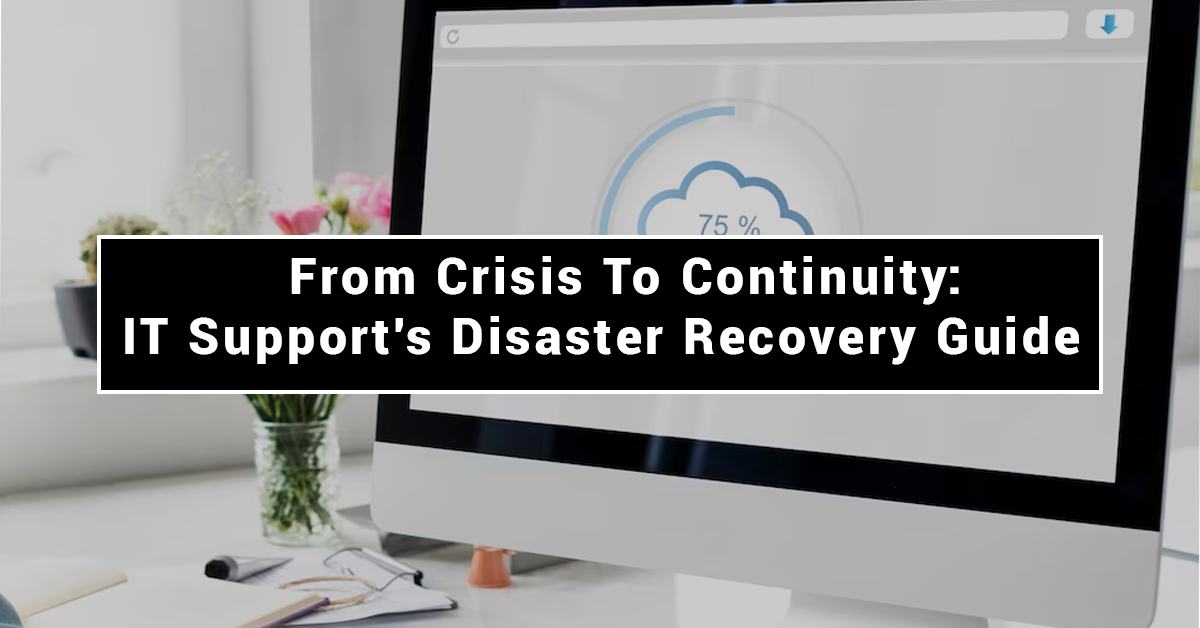In today's fast-paced digital landscape, businesses rely heavily on their IT infrastructure to operate efficiently. However, unforeseen disasters can strike at any moment, jeopardizing the continuity of operations and threatening a business's very existence. This is where robust disaster recovery services come into play.
In this comprehensive guide, we'll explore disaster recovery, its importance, key components, and best practices while explaining how IT support services in Mason, Ohio, can help businesses navigate crises and ensure continuity.
What is Disaster Recovery?
Disaster recovery is a proactive approach to mitigating the impact of unforeseen events such as natural disasters, cyber-attacks, hardware failures, or human error. Its primary objective is to minimize downtime, data loss, and financial losses, enabling businesses to resume operations swiftly with minimal disruption.
The Importance of Backup And Disaster Recovery Services
Disaster recovery is a proactive strategy designed to minimize the impact of unforeseen events on business operations and data integrity. It involves implementing measures to quickly recover from disruptions such as cyberattacks, hardware failures, and natural disasters. With a robust disaster recovery plan, businesses can mitigate the financial, operational, and reputational risks of downtime and data loss.
Critical Components of Disaster Recovery
1. Risk Assessment
Conducting a comprehensive risk assessment is the first step in crafting a disaster recovery plan. This involves identifying potential threats, assessing their impact on business operations, and prioritizing recovery efforts accordingly.
2. Backup and Recovery
Data is the lifeblood of modern businesses, making backup and recovery a critical component of any disaster recovery strategy. Our IT support company in Mason, Ohio, employs advanced backup technologies to ensure data redundancy and facilitate swift recovery during data loss.
3. Infrastructure Redundancy
Redundancy is the key to resilience. IT support services in Mason deploy redundant hardware, networks, and infrastructure components to minimize the risk of single points of failure and ensure uninterrupted service delivery.
4. Disaster Response Plan
A well-defined disaster response plan outlines the actions to be taken during and after a disaster, including communication protocols, escalation procedures, and resource allocation strategies.
5. Testing and Training
Regular testing and training exercises are essential to validate the effectiveness of the disaster recovery plan and familiarize stakeholders with their roles and responsibilities during a crisis.
Related Blog: Data Disasters: A Comprehensive Guide to Data Loss Prevention
The Challenges of Lacking Backup & Disaster Recovery Services:
1. Data Loss
With adequate backup and disaster recovery services, businesses can retain critical data during a disaster. Failure to do so can result in financial losses, compliance violations, and damage to reputation.
2. Downtime
Downtime can significantly impact business operations, causing a loss of productivity, revenue, and customer trust. With a plan to quickly restore operations, businesses can recover from the financial impact of downtime.
3. Security Vulnerabilities
Lacking disaster recovery services can leave businesses vulnerable to cyber threats and security breaches. Hackers may exploit weaknesses in backup systems or target unprotected data, leading to further disruptions and data breaches.
4. Regulatory Compliance
Many industries have strict regulatory requirements regarding data protection and disaster recovery. Businesses without adequate disaster recovery measures may fail to comply with these regulations, risking legal consequences and financial penalties.
Related Blog: Importance of Data Backup And Storage in the Data-Driven World
Best Practices for Disaster Recovery
1. Establish Clear Objectives
Define recovery objectives, such as Recovery Time Objectives (RTOs) and Recovery Point Objectives (RPOs), to guide the disaster recovery process and set realistic expectations.
2. Regular Updates and Maintenance
Keep the disaster recovery plan up-to-date with the evolving threat landscape and changes in business requirements. Regular maintenance and audits are conducted to ensure its effectiveness.
3. Collaboration and Communication
Foster collaboration between IT teams, business units, and external stakeholders to facilitate seamless coordination during a crisis. Establish robust communication channels to keep all stakeholders informed and updated throughout the recovery process.
4. Continuous Monitoring
Implement proactive monitoring tools and processes to detect potential issues before they escalate into full-blown disasters. Early detection enables swift intervention and minimizes the impact on business operations.
5. Documentation and Documentation
Document every aspect of the disaster recovery plan, including procedures, responsibilities, and contact information. Maintain detailed records of past incidents and lessons learned to improve future response efforts.
How Can Our IT Support Services in Mason Help?
1. Comprehensive Backup Solutions
Our IT support services offer comprehensive backup solutions tailored to the needs of Mason businesses. We ensure that critical data is regularly backed up and securely stored offsite to protect against data loss.
2. Disaster Recovery Planning
We work closely with businesses to develop customized disaster recovery plans that outline procedures for responding to various scenarios. Our plans include steps for minimizing downtime, restoring operations quickly, and communicating with stakeholders.
3. Proactive Monitoring and Maintenance
Our proactive monitoring and maintenance services help identify potential issues before they escalate into disasters. We continuously monitor system health and performance, allowing us to take preemptive action and prevent disruptions.
4. Security Enhancements
We implement robust security measures, such as encryption, multi-factor authentication, and intrusion detection, to protect data against cyber threats. Our security enhancements help businesses safeguard their sensitive information and prevent unauthorized access.
5. 24/7 Support and Assistance
Our IT support team in Mason is available 24/7 to assist immediately during a disaster. We offer rapid response times and personalized service to ensure businesses have access to the resources and expertise needed to recover swiftly.
6. Risk Assessment and Analysis
Conduct comprehensive risk assessments to identify potential threats and vulnerabilities, allowing businesses to tailor their disaster recovery strategies accordingly.
7. Infrastructure Redundancy and Resilience
Implement redundant hardware, networks, and infrastructure components to minimize downtime and ensure uninterrupted service delivery.
8. Testing and Training
Conduct regular testing and training exercises to validate the effectiveness of the disaster recovery plan and familiarize stakeholders with their roles and responsibilities during a crisis.
Conclusion!!
The journey from crisis to continuity requires meticulous planning, proactive measures, and the expertise of IT Support Companies in Mason. By understanding the importance of disaster recovery, building comprehensive plans, implementing robust backup and recovery strategies, and staying vigilant against evolving threats, businesses can navigate through crises with resilience and ensure continuity of operations even in the face of adversity. Remember, the key to effective disaster recovery lies in preparedness and collaboration with trusted IT Support partners.
Contact us today to learn more about how our IT support services can help your business navigate through crises and ensure continuity of operations.








You must be logged in to post a comment.